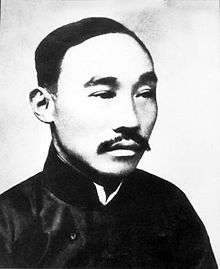He Shuheng
| He Shuheng 何叔衡 | |
|---|---|
 He Shuheng in young age | |
| Personal details | |
| Born |
7 May 1876 Ningxiang, Hunan, China |
| Died |
24 February 1935 (aged 58) Changting, Fujian, China |
| Nationality | Chinese |
| Political party | Communist Party of China |
| He Shuheng | |||||||||
| Chinese | 何叔衡 | ||||||||
|---|---|---|---|---|---|---|---|---|---|
| |||||||||
He Shuheng (Chinese: 何叔衡; 1876–1935) was a Chinese Communist revolutionary. His hometown was Ningxiang, Hunan province. He won the 'scholar of Qing Dynasty' from Hunan provincial first normal school. He was a foundation member of the Xinmin Society (a revolutionary group). He also was a member of the Changsha Communist Group.
Biography
In 1914, He Shuheng made the acquaintance of Mao Zedong and became the best of friends in Changsha, Hunan. They were classmate in the first Hunan Normal University.
In April, 1918, He Shuheng and Mao Zedong organized the Xinmin Institute in Changsha and acted as the official of the executive committee.
In 1920, He Shuheng launched into the organization of the Russian Study Institute with Mao Zedong, and they founded a precursor organisation of the Communist Party of China (CPC) together.
In July, 1921, He Shuheng attended the first National Congress of the CPC in Shanghai. After the congress, He Shuheng became a member of the CPC’s Hunan committee. During the first cooperation between Kuomintang (KMT) and CPC, He Shuheng was a member of the KMT’s executive committee and supervision committee of the KMT's local party in Hunan. In 1927, He Shuheng went to Shanghai. After the April 12 Incident, He Shuheng established a print factory, secretly, for the CPC in Changsha.
He Shuheng went to Russia to attend the Sixth National Congress of the Communist Party of China in April 1928. Hé enter into Moscow Sun Yat-sen University, and studied in a special class with Xu Teli, Wu Yuzhang, Dong Biwu, Lin Boqu during September.
Afterwards, He Shuheng went back to China in July 1930. He Shuheng took charge of the National Huji Institute and organized the rescue of arrested comrades and to transfer comrades to safe places.
He Shuheng accepted the order to enter the Central Revolutionary Base. He Shuheng and Mao Zedong were leaders of the Chinese Worker's and Peasant's Democratic Government.
Establishment of the Communist Party of China
In 1920 Li Dazhao met Comintern Russian agent Grigori Voitinsky.The location of the first Congress of the Communist Party of China, in July 1921, was Xintiandi district in the French Concession of Shanghai.
Marxist ideas had started to spread widely in China after the 1919 May Fourth Movement. In June 1920, Comintern agent Grigori Voitinsky was sent to China, and met Li Dazhao and other reformers. He financed the founding of the Socialist Youth Corps. The Communist Party of China was initially founded by Chen Duxiu and Li Dazhao in the French concession of Shanghai in 1921 as a study society and an informal network.
There were informal groups in China in 1920, and also overseas, but the official beginning was the 1st Congress held in Shanghai and attended by 53 men in July 1921 and later transferred from Shanghai to Jiaxing. The birth of the party was declared here in a boat on South Lake. It is therefore considered by the Chinese to be one of the most important historical places of the revolution.
The formal and unified name Chinese Communist Party (pinyin: Zhōngguó Gòngchǎn Dǎng) was adopted and all other names of communist groups were dropped and the final agenda was carried out. The key players were Li Dazhao, Chen Duxiu, Chen Gongbo, Tan Pingshan, Zhang Guotao, He Mengxiong, Lou Zhanglong and Deng Zhongxia. Mao Zedong was present at the first congress as one of two delegates from a Hunan communist group. Other attendees included Dong Biwu, Li Hanjun, Li Da, Chen Tanqiu, Liu Renjing, Zhou Fohai, He Shuheng, Deng Enming, and two representatives from the Comintern, one of them being Henk Sneevliet (also known by the single name 'Maring'). Notably absent at this early point were future leaders Li Lisan and Qu Qiubai.
References
| Wikimedia Commons has media related to He Shuheng. |